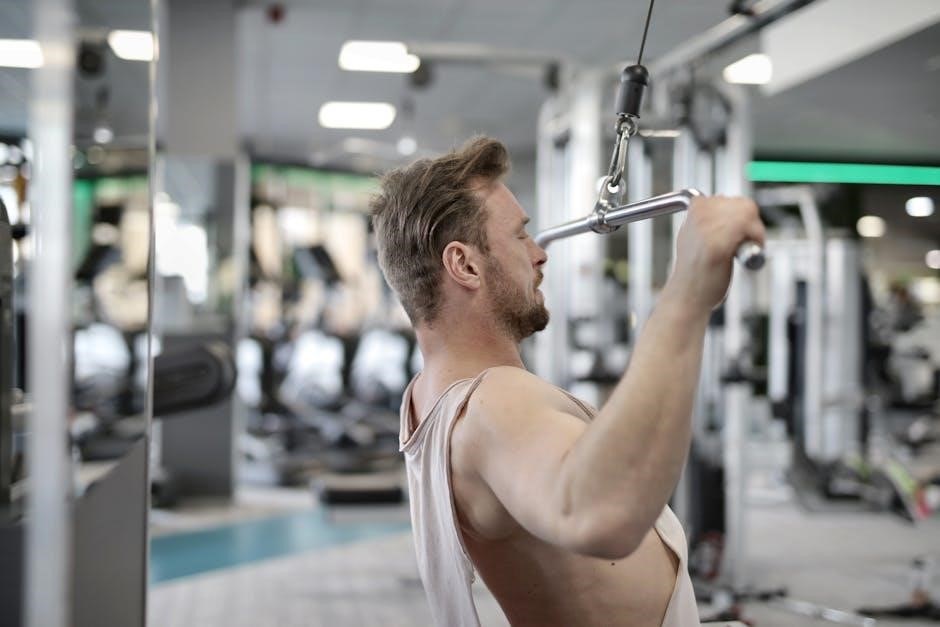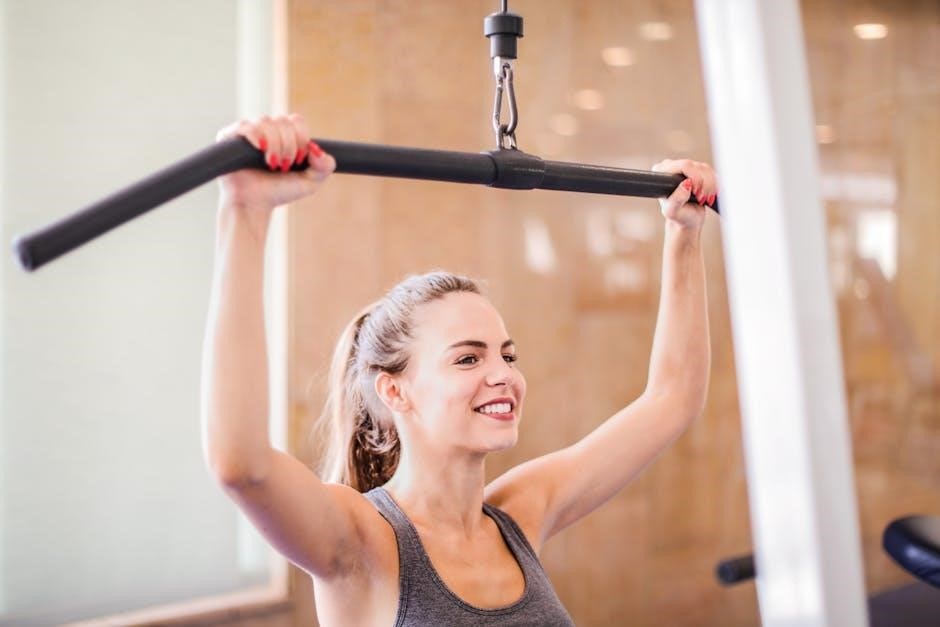The latissimus dorsi is a large‚ flat muscle in the back that plays a key role in movement and stability. It spans from the armpits to the lower back‚ aiding in actions like pulling‚ twisting‚ and maintaining posture. Strengthening and stretching this muscle is essential for both athletes and individuals with sedentary lifestyles to prevent injuries and improve overall mobility.
1.1. Anatomy and Function of the Latissimus Dorsi
The latissimus dorsi is a large‚ flat muscle in the upper back that spans from the armpits to the lower back. It originates from the spinous processes of the lower thoracic and lumbar vertebrae‚ sacrum‚ and iliac crest‚ inserting into the bicipital groove of the humerus. This muscle facilitates movements like pulling‚ twisting‚ and extending the shoulder joint‚ while also stabilizing posture and assisting in breathing.
1.2. Importance of Stretching the Latissimus Dorsi
Stretching the latissimus dorsi prevents tightness and enhances mobility. Regular stretching relieves muscle tension and pain‚ improving posture and reducing injury risk. It also boosts athletic performance by increasing flexibility and range of motion. Additionally‚ stretching supports rehabilitation and maintains muscle balance‚ essential for overall physical fitness and daily activities.
Benefits of Stretching the Latissimus Dorsi
Stretching the latissimus dorsi improves flexibility‚ relieves muscle tension‚ enhances athletic performance‚ and supports good posture. Regular stretching also prevents injuries and promotes overall muscle balance.
2.1. Improved Flexibility and Range of Motion
Stretching the latissimus dorsi enhances flexibility by elongating muscle fibers‚ allowing for greater range of motion in the shoulders and lower back. This improved mobility aids in daily activities and athletic performance‚ reducing stiffness and discomfort. Regular stretching also prevents muscle imbalances‚ promoting a more fluid and efficient movement pattern overall.
2.2. Relief from Latissimus Dorsi Pain and Tension
Stretching the latissimus dorsi can alleviate pain and tension caused by overuse or poor posture. Techniques like the cat stretch and table-assisted lat stretch target muscle tightness‚ reducing discomfort. Regular stretching helps relax the muscle‚ improving circulation and relieving stiffness‚ which is especially beneficial for individuals with chronic lat strain or occupational-related tension.
2.3. Enhanced Athletic Performance
Stretching the latissimus dorsi enhances athletic performance by improving power‚ speed‚ and endurance. It boosts flexibility and range of motion‚ crucial for sports involving pulling or overhead movements. Regular stretching reduces muscle stiffness‚ allowing for more efficient energy transfer during activities like swimming‚ rowing‚ or gymnastics. This optimization enables athletes to perform at higher intensities with better technique and reduced injury risk.

Common Latissimus Dorsi Stretches
Popular stretches include the cat stretch‚ doorway lat stretch‚ kneeling lat stretch‚ and table-assisted lat stretch. These exercises target the latissimus dorsi effectively‚ improving flexibility and reducing tension.
3.1. Cat Stretch for Latissimus Dorsi
The cat stretch targets the latissimus dorsi by arching the back and extending the arms. Start on all fours‚ inhale while rounding the spine‚ and exhale as you stretch forward. This exercise relieves tension‚ improves flexibility‚ and enhances posture. It’s a gentle yet effective stretch for both athletes and individuals seeking relaxation.
3.2. Doorway Lat Stretch
The doorway lat stretch is an effective way to target the latissimus dorsi. Stand in a doorway with hands on the frame at shoulder height. Lean forward gently‚ stretching the chest and lats. Hold for 30 seconds and repeat. This stretch improves flexibility‚ reduces muscle tightness‚ and enhances posture. It’s ideal for daily routines or post-workout recovery.
3.3. Kneeling Lat Stretch
Kneel on the ground with arms extended forward at shoulder height. Slowly lower your head and chest toward the floor‚ keeping your hips stable. Hold for 20-30 seconds to feel a stretch in the latissimus dorsi. This stretch improves flexibility and relieves tension in the upper back; Focus on deep breathing to enhance the stretch and avoid bouncing.
3.4. Table-Assisted Lat Stretch
Place your hands on the edge of a sturdy table and position your feet shoulder-width apart. Bend forward at the hips‚ allowing your arms to extend while keeping your elbows slightly bent. Lower your torso until you feel a stretch across your latissimus dorsi. Hold for 20-30 seconds‚ maintaining controlled breathing to maximize the stretch and avoid discomfort.
Dynamic and Passive Stretching Techniques
Dynamic stretching involves active movements to improve flexibility‚ while passive stretching uses prolonged holds to release tension. Both techniques target the latissimus dorsi for enhanced mobility and relaxation.
4.1. Dynamic Stretching for Latissimus Dorsi
Dynamic stretching for the latissimus dorsi involves active movements that target the muscle’s range of motion. Exercises like arm circles‚ side bends‚ and torso twists are effective. These stretches improve flexibility and prepare the muscle for physical activity. Regular practice can enhance athletic performance and reduce the risk of injury. Consistency is key for optimal results.
4.2. Passive Stretching Exercises
Passive stretching for the latissimus dorsi involves holding static stretches to lengthen the muscle. Techniques include doorframe stretches‚ tabletop stretches‚ and kneeling lat stretches‚ which target the muscle’s deep fibers. These exercises are typically held for 20-30 seconds and require minimal movement‚ making them ideal for post-workout recovery and improving overall flexibility. They promote relaxation and reduce muscle tension effectively.
Incorporating Resistance Bands for Lat Stretches
Resistance bands add versatility to latissimus dorsi stretches‚ providing adjustable tension to deepen stretches. They are portable and ideal for enhancing flexibility and strength in the lats.
5.1. Using Resistance Bands for Enhanced Stretching
Resistance bands offer a dynamic way to stretch the latissimus dorsi‚ allowing for controlled tension. By anchoring the band to a stable object‚ users can perform seated or standing stretches‚ targeting the lats effectively. This method enhances flexibility‚ improves range of motion‚ and strengthens the muscle without the need for heavy equipment‚ making it ideal for home use.
5.2. Band-Assisted Lat Stretch Routine
A band-assisted lat stretch routine involves looping the resistance band around a stable object. Start with the cat stretch‚ pulling the band toward your chest‚ then transition to a doorway lat stretch. Use the band to deepen the stretch‚ holding each position for 20-30 seconds. Repeat for 3 sets‚ ensuring slow‚ controlled movements to avoid injury and maximize flexibility. This routine enhances both stretch depth and muscle engagement.

Post-Operative and Rehabilitation Stretches
Post-operative and rehabilitation stretches for the latissimus dorsi focus on restoring mobility and strength after surgery or injury. Gentle exercises‚ like cat stretches and table-assisted stretches‚ are often recommended to promote healing and prevent stiffness‚ ensuring a safe and gradual return to normal activity levels.
6.1. Latissimus Dorsi Stretches After Surgery
Post-surgical stretches for the latissimus dorsi are designed to restore flexibility and strength gradually. Gentle exercises like the cat stretch and seated forward bends are recommended. These stretches help prevent scar tissue formation and improve range of motion. Patients should start with short sessions‚ ensuring not to overextend‚ and progress slowly under medical guidance to avoid complications.
6.2. Rehabilitation Exercises for Latissimus Dorsi Injuries
Rehabilitation exercises for latissimus dorsi injuries focus on restoring strength and flexibility. Gentle stretches‚ such as the cat stretch and seated forward bends‚ are often recommended. Resistance bands can also be used to gradually strengthen the muscle without overstraining. Proper technique and gradual progression are crucial to ensure a full recovery and prevent further injury.

Stretching Routines for Specific Needs
Customized stretching routines address individual requirements‚ such as athletic performance or sedentary lifestyle adjustments. Tailored exercises enhance flexibility and strength‚ ensuring optimal results for diverse fitness levels and goals.
7.1. Stretching for Athletes and Active Individuals
Athletes and active individuals benefit from dynamic and targeted latissimus dorsi stretches to enhance performance and prevent injuries. Exercises like the cat stretch and doorway lat stretch improve flexibility‚ while resistance bands provide additional resistance for deeper stretches. Incorporating these routines into training regimens ensures optimal muscle balance‚ reducing the risk of overuse injuries and improving overall athletic efficiency and endurance.
7.2. Stretching for sedentary lifestyle
7;2. Stretching for a Sedentary Lifestyle
Individuals with sedentary lifestyles benefit from gentle latissimus dorsi stretches to improve posture and reduce muscle stiffness. Simple exercises like the cat stretch or seated lat stretches can be done at home. Incorporating these into a daily routine helps maintain flexibility and prevents tightness‚ promoting better overall comfort and movement without requiring intensive physical activity or equipment.
Combining Stretching with Strengthening Exercises
Combining stretching with strengthening exercises enhances flexibility and muscle tone‚ promoting overall fitness. This balanced approach improves posture‚ reduces injury risk‚ and boosts athletic performance effectively.
8.1. Strengthening Exercises for Latissimus Dorsi
Strengthening the latissimus dorsi involves exercises like pull-ups‚ rows‚ and lat pulldowns‚ which target the muscle’s ability to pull and stabilize. Deadlifts and Superman exercises also engage the lats‚ improving posture and reducing injury risk. Resistance bands can enhance these workouts‚ providing controlled resistance to build strength and endurance effectively.
8.2. Balancing Stretching and Strengthening
Balancing stretching and strengthening is crucial for optimal latissimus dorsi health. Stretching improves flexibility and reduces injury risk‚ while strengthening builds muscle power and endurance. A well-rounded routine combines both‚ ensuring the muscle remains adaptable and robust. This balance supports overall performance‚ prevents imbalances‚ and maintains long-term muscle integrity and function.

Creating a Latissimus Dorsi Stretching PDF Guide
A comprehensive PDF guide on latissimus dorsi stretches should include detailed instructions‚ visuals‚ and routines. Organize content clearly‚ ensuring each stretch is explained with proper form and duration for maximum effectiveness and safety.
9.1. Structuring the PDF for Clarity
Organize the PDF with clear sections‚ starting with an introduction to the latissimus dorsi muscle. Include high-quality images and diagrams to demonstrate each stretch. Provide step-by-step instructions for proper form and safety. Categorize stretches by difficulty and purpose‚ such as post-operative or athletic-focused routines. Add a quick-reference guide for easy navigation‚ ensuring the content is visually appealing and easy to follow for all users.
9.2. Including Visual Aids and Instructions
Enhance understanding and safety by incorporating detailed visuals‚ such as diagrams and photographs‚ to illustrate proper form and technique. Pair each stretch with clear‚ step-by-step instructions to guide users through the movements. Include arrows or labels to highlight muscle engagement and movement directions. Add tips for modifying stretches based on fitness levels to ensure accessibility and effectiveness for all individuals.
Safety and Precautions
Avoid overstretching to prevent injury. Modify stretches based on fitness levels. Use proper technique to avoid strain. Consult a professional for personalized guidance‚ especially after injuries or surgeries.
10.1. Avoiding Overstretching and Injury
Overstretching can cause micro-tears or discomfort. Start slowly‚ holding stretches 20-30 seconds. Breathe deeply to relax muscles. Stop if pain occurs. Warm up before stretching and cool down after. Listen to your body to avoid injury and ensure safe‚ effective stretching routines for the latissimus dorsi muscle.
10.2. Modifying Stretches for Different Fitness Levels
Adjust stretches based on fitness levels. Beginners can start with gentle‚ static stretches like the cat stretch. Intermediate individuals can incorporate resistance bands for deeper stretches. Advanced users may opt for dynamic or proprioceptive neuromuscular facilitation (PNF) stretching. Modify intensity and duration to suit individual capabilities‚ ensuring safe and effective progress for all fitness levels.

Recovery and Maintenance
Post-stretch recovery involves foam rolling and heat therapy to relax muscles. Regular maintenance includes consistent routines and complementary exercises like yoga to sustain flexibility and prevent injury.
11.1. Post-Stretch Recovery Techniques
After stretching‚ recovery techniques like foam rolling and heat therapy can reduce muscle soreness. Gentle movements and deep breathing help relax the latissimus dorsi‚ promoting blood flow and flexibility. Incorporating these methods ensures long-term muscle health and prevents stiffness‚ making them essential for both athletes and individuals with sedentary lifestyles.
11.2. Maintaining Flexibility Long-Term
Regular stretching‚ combined with strengthening exercises‚ helps maintain latissimus dorsi flexibility. Incorporating dynamic and passive techniques‚ along with resistance bands‚ ensures consistent progress. A structured routine‚ as outlined in a latissimus dorsi stretches PDF‚ promotes long-term muscle health and prevents stiffness‚ benefiting both athletes and individuals with sedentary lifestyles.
12.1. Summary of Key Points
Regular stretching of the latissimus dorsi improves flexibility‚ reduces muscle tension‚ and enhances athletic performance. Techniques like cat stretches‚ doorway lat stretches‚ and resistance band exercises are effective. Incorporating both dynamic and passive stretching‚ along with post-operative rehabilitation routines‚ supports overall muscle health. Balancing stretching with strengthening exercises ensures optimal muscle function and long-term flexibility.
12.2. Encouragement for Regular Stretching Practice
Regular stretching of the latissimus dorsi is essential for maintaining flexibility and reducing muscle tension. Incorporate stretching into your daily routine to enhance athletic performance and overall well-being. Consistency will help prevent injuries and improve posture. Make stretching a habit to empower your body and refresh your mind for a healthier‚ active lifestyle.

Additional Resources
Downloadable PDF guides and scientific articles provide comprehensive insights into latissimus dorsi stretches. Explore recommended readings and references for detailed exercise routines and rehabilitation techniques.
13.1. Recommended Reading and References
Scientific studies and rehabilitation guides highlight the importance of latissimus dorsi stretches. Works by O.A. MaharIN and Bulletin of Rehabilitation Medicine provide detailed insights. Downloadable PDFs offer structured routines‚ including exercises like the cat stretch and doorway lat stretch‚ to enhance flexibility and strength. These resources are essential for athletes and individuals recovering from injuries‚ ensuring safe and effective practices.
13.2. Downloadable PDF Guide
A comprehensive PDF guide on latissimus dorsi stretches offers detailed routines‚ visual aids‚ and instructions. It includes stretches like the cat stretch and table-assisted lat stretch‚ tailored for athletes‚ individuals with injuries‚ and those with sedentary lifestyles. The guide provides clear‚ portable instructions‚ making it easy to follow anytime‚ anywhere‚ ensuring effective and safe stretching practices.

